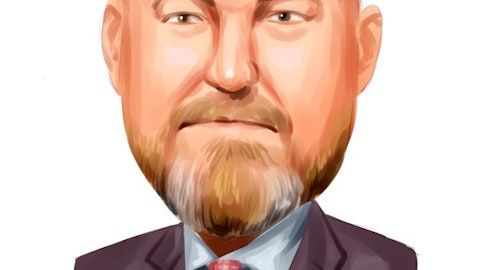Sharon Zackfia: Okay. Thank you.
Richard Brooks: Thanks Sharon.
Operator: Thank you. One moment for our next question. And that will come from the line of Mitch Kummetz with Seaport. Please go ahead.
Mitch Kummetz: Yes, thanks for taking my questions. I’ll just ask them one at a time. I was curious on the comp, so on the quarter to date comp, is there any way you can kind of talk about the period of Black Friday through Cyber Monday, if that was any better than what the quarter to date is, or if it’s pretty much in line?
Christopher Work: Sure. I’ll take that question and the answer is it’s pretty much in line. I think when we looked at the quarter, and we’ve obviously, as you would expect, sliced and diced this quite a few ways, trying to kind of think through how this is coming together. I think what’s different is we went through the quarter in this Black Friday weekend compared to the same Black Friday weekend last year, is we did run product margin gains pretty meaningfully. Last year at this time we were trying to move through some inventory and it just had a bigger impact on margin, some of the promotion we had last year. So — but overall, trendline was pretty consistent across the quarter, week to week. And maybe the main difference being how product margin performed over the holiday weekend.
Mitch Kummetz: Okay. And then on the quarter to-date, you guys gave us sales and comp for that period. Do you know what that is on a three-year?
Christopher Work: I don’t have it on a three-year off the top of my head.
Mitch Kummetz: Okay. Do you know if the full year or the full quarter guide assumes kind of a similar three-year for the full quarter versus quarter date? You probably don’t. No. That off the top of your too. Okay. A couple last things. Maybe, Rick, you talked about the trading down that you’re experiencing. Can you just maybe elaborate a little bit more on how you’re addressing that, when you think about maybe your mix of product and brands, and particularly if there’s any sort of trying to elevate the exclusive brand side of your business?
Richard Brooks: Sure. Mitch, I’d be glad to. We are — what we’re seeing in this situation, I feel on the whole pretty good about our core consumer. Even over the Black Friday weekend, we saw our — what I consider to be good signs about our core consumer, we saw much higher conversion rates and much larger basket sizes. We saw our core consumers staying true to doing business with us. And — but what we are seeing in reflective in that is, is the mix of penetration to our private label is significantly — private label significantly growing. So, this clearly reflects the way that we can convey value for that core consumer. And it’s resonating, it’s working because again, the penetration of private label is up significantly year-to-date and even higher here in the fourth quarter to-date period.
It’s been gaining throughout the year. So to me, Mitch, that is the way through what we’re doing in bundling and price points and two for deals and all the things we’re doing, how we use private label, it does two things. First, it delivers value for our customer. And second, it helps us on the margin side of the business. Again, because private liberals higher margins than our branded partners. Now, on the branded side, we are reluctant. As you know, Mitch, when we have brands that have equity and have real value that can sell a full price, we’re reluctant to do markdowns because we think it’s a disservice to our brand partners. And I tell you, our brand partners feel the same way. So, in there, we’re trying to be disciplined about how much we buy, how we move through product for our brand partners, how we work with our brand partners in terms of flowing the product, to make sure that we’re not getting overstock situation with them.
And we — don’t get me wrong, we’ll be aggressive if we own too much and we’ll take markdowns and move through the product. But the goal is to manage it and to basically drive markdowns to where we need to liquidate, whether it be seasonal product or again things that haven’t worked out is kind of how we’re approaching this, but we don’t want to destroy brand equity for our brand partners either.
Mitch Kummetz: That’s helpful, Rick. And then maybe one last question just on the skate business. I know that’s been more difficult over the last probably six quarters or so. I mean it kind of rebounded before COVID and then it accelerated with COVID. And you saw the kind of penetration levels go from I think it was like 11% in 2018 to up to 19% and maybe it was 2021. I’m curious if, at this point, maybe like on a trailing basis, is the penetration of hardgoods kind of backed down to levels where it was at before kind of the rebound and acceleration? Or is it still above where it was for that period?
Richard Brooks: Yeah. It’s a good question, Mitch. As you saw in Chris’s comments, he commented that skate hardgoods were our second largest declining department. And remember that it’s relatively small percent of sales. So that still tells you about something about the scale of the diminishing sales in that department on a relatively small mix of our sales in its position as second largest declining department. So, we haven’t hit bottom yet, is my message for you is what we’re saying at this point. We’re getting down to all time lows at this point, Mitch. But there’s no doubt, as you said that 2021, the penetration was of significantly above our all time highs for penetration of the skate hardgoods department. So, we’re definitely giving that back up relative to, as you said, the recovery start in skate hardgoods in 2019 and how, what the pandemic did to accelerate significantly, I think pull forward of demand.
So, now we’re giving it back and that’s just the way our business works, right? Things trend up, things trend down, and particularly skate. We’ve seen that skate cycle many times. I think what we’re seeing this time though is a massively accelerated cycle. And now we’re taking a bit of pain as we fall back to what — where we’re going to bottom out and we may stay at a bottom for a period of time, the losses will diminish and then we’ll start the cycle back up at some point.
Mitch Kummetz: Okay. Thanks for that update. Yeah. Go ahead.
Christopher Work: And Mitch, just clarify on the growth curve, it was — 2018 was 10%, 2019 was 13%. And then 2020 was our peak. We got all the way to 19%. I think that’s when we really saw outsize skate sales during the closure in the 2020 year. And then last year was 15%. So, still very, very healthy to where we’ve been. And the current run rate would be trending at our lowest that we’ve had for quite some time. So, we are expecting that to continue to decline as Rick said.
Mitch Kummetz: Okay. Thanks for that and good luck for holiday.
Richard Brooks: Thank you, Mitch.




